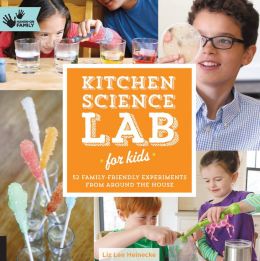I am one of those librarians who still likes getting print catalogs (hello - I'm ordering books in print, why would I want to look at them on your web site?), and I love getting catalogs from new (to me, anyway) publishers. A couple months ago I received one from Quarto Publishing group, and immediately saw several titles that looked interesting. But - flexibound? What exactly is that? Most importantly, is it something that will hold up on our shelves? I e-mailed the company, and they graciously sent me a copy of this title:

9781592539253
"At-home science provides an environment for freedom, creativity and invention that is not always possible in a school setting. In your own kitchen, it's simple, inexpensive, and fun to whip up a number of amazing science experiments using everyday ingredients. Science can be as easy as baking. Hands-On Family: Kitchen Science Lab for Kids offers 52 fun science activities for families to do together. The experiments can be used as individual projects, for parties, or as educational activities groups. Kitchen Science Lab for Kids will tempt families to cook up some physics, chemistry and biology in their own kitchens and back yards. Many of the experiments are safe enough for toddlers and exciting enough for older kids, so families can discover the joy of science together."
First, the binding - think very flexible but sturdy sort of plastic, the look of a shiny paperback but heavier. The actual end binding looks to be quite firmly stitched, nothing that is going to come loose any time soon. I think it will be fine in our nonfiction or chapter books, and I may even give it a go in the picture books.
As for the content: what a fun book! We love trying out science experiments at home, and this has all the classics: Diet Coke and Menthos, for example.
The thing is, while explosions are always good for attention, I have a hard time explaining on a three-year-old level exactly WHY they happened. What I loved about this book is that each experiment comes with a paragraph or two of scientific explanation that is simple enough for even those of us with giant mental-science-blocks to understand and paraphrase as needed.
We tried many of the experiments, and plan to do more. Most use very simple, cheap materials.
A head of purple cabbage, shredded and boiled,
add some baking soda to one portion,
and some vinegar to another,
and you are learning about acids and bases! Plenty of juice left in the pot to try out other substances. Of course, now that you have baking soda and vinegar, you HAVE to put them together - outside!
Minor explosion!
And it turned back to the original purple. An unintended experiment happened when I tossed this mess in the dirt - and it all fizzed and bubbled! Acid soil? I think we need more cabbage...
Monster eyes were fun. Put plain eggs in vinegar overnight, and the shells dissolve, but the membranes remain. You can pick them up, and they feel rubbery - squeeze, and the liquid egg runs out.
Another unintended lesson, bubbles formed on the eggs and made some rise to the top and then sink as they popped - two lessons in one!
 |
| Logan is mad because his hasn't risen yet. |
You've seen the food coloring in milk one on Facebook, right?
 |
| Okay, cheesy ones, THAT'S realistic. |
This one (on page 56) deals with surface tension, but happened too fast to take pictures. It worked, though!
And then we played in the water for a while, because - water!
I plan to get this on the shelves at some point, but we are having too much fun playing with it right now! I do also plan to buy more from Quarto, because this one was a definite hit all the way around.









No comments:
Post a Comment